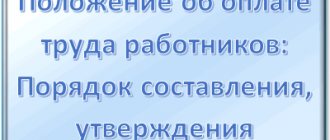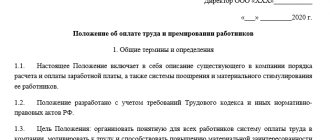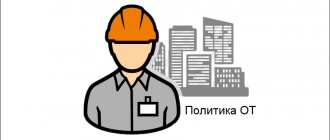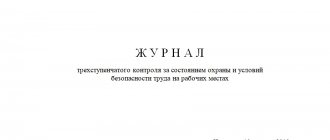Rate this article!
Guiding document on the occupational safety management system - Regulations on the occupational safety management system, drawn up according to the standard model proposed in the Standard Regulations of the occupational safety management system (approved by order of the Ministry of Labor of the Russian Federation dated August 19, 2016 No. 438N). However, it is not enough to take and copy a document - you need to correctly “customize” it for your organization, taking into account all its features in the field of labor protection. How to create and configure such a document will be discussed in this article.
What does the guidance document on the occupational safety and health management system consist of?
The Regulations are the main document containing a summary of all documents. In essence, the document plays an aggregating role and contains:
- general provisions;
- employer's policy and goals in the field of labor protection;
- distribution of labor protection responsibilities;
- procedures aimed at achieving occupational safety goals;
- planning occupational safety measures;
- monitoring the functioning of the OSMS;
- planning for HSE improvements;
- response to accidents and incidents;
- management of OSMS documents.
Which regulations establish requirements for the preparation and structure of the document?
Despite the fact that drafting a regulation is an obligation established at the federal level, the Russian Federation has not adopted regulations regulating how this document should be formed and what it should look like.
In Art. 209 of the Labor Code of the Russian Federation states that it is within the competence of federal authorities to approve a standard provision on the occupational safety management system, which should be formed taking into account the opinion of the bodies regulating social and labor legal relations.
However, such a standard provision has not yet been adopted as a normative document. True, it was published in the form of a draft by the Ministry of Labor of the Russian Federation, which is now being actively discussed by various departments.
This document was developed taking into account the current labor protection standards adopted in the Russian Federation and abroad, as well as the practical experience of leading employer companies. The draft standard provision contains, in particular:
- requirements for the structure of internal corporate regulations;
- provisions defining the policy and goals of the employer company in the field of labor protection;
- provisions establishing how the company's labor protection system should operate;
- provisions defining how personnel training in the field of labor protection should be carried out;
- provisions regulating the organization of document flow within the framework of the labor protection system at the enterprise.
At a meeting of the Russian Tripartite Commission, which took place in early February 2021, it was decided that the current draft standard regulation of the Ministry of Labor needs to be finalized. Experts noted that this document assumes that employing companies will face a number of unjustified risks.
In the absence of legal provisions that would regulate the preparation of regulations on the occupational safety management system, Russian employers will have to work on developing this source independently. Let's study how this problem can be solved.
The nuances of drawing up the regulations on the occupational safety management system were explained by ConsultantPlus experts:
Study the material by getting trial access to the K+ system for free.
What should be taken into account when drawing up regulations on the occupational safety management system?
- Distribution of responsibilities in the field of occupational safety among officials.
Take care to choose the right levels of management to create a clear and simple organizational structure for occupational safety. Remember that if your organization is small, then the occupational safety management system can be significantly simplified. - Professional risks.
Select only those risks that are relevant to your organization - taking into account the risks of incidents that have a zero probability of occurring in your company will only add unnecessary paperwork. - Procedures aimed at achieving occupational safety goals.
Select from all the procedures those that relate to the activities of your company. For example, not every company requires occupational safety training, personal protective equipment, or medical examinations.
Section 3: Functional Responsibilities of Employees
Here is a list of employees responsible for:
- control over the functioning of the labor protection system in the company;
- ensuring compliance of local regulations of the company, adopted for the purpose of functioning of the labor protection system, with the provisions of legal acts at the federal, regional and local levels;
- monitoring the implementation of the provisions of local acts in the field of labor protection by employees;
- developing methods for improving the current mechanisms within which the labor protection system operates;
- organizing training for employees aimed at acquiring knowledge in the field of labor protection;
- practical implementation of the standards governing the functioning of the labor protection system at the enterprise, in terms of providing employees with protective equipment, instructions for their use, access to security systems and other infrastructure facilities of the enterprise, which are involved in the process of labor protection;
- responding to industrial incidents and ensuring their investigation;
- implementation of social protection measures for employees from industrial incidents and occupational diseases;
- conducting a special assessment of working conditions in the manner prescribed by the legislation of the Russian Federation;
- conducting training for employees on occupational safety programs with the involvement of freelance instructors from specialized organizations or departments;
- control over the correct maintenance of documentation used within the framework of the labor protection system at the enterprise.
Results
The regulation on the labor protection system at the enterprise is a document that, in accordance with GOST standards, all Russian employers must have. Since its recommended form has not been approved at the moment, the enterprise must develop this document independently. The structure of the regulation on the labor protection system proposed by our experts is based on the practice of modern personnel management and reflects the basic requirements of the regulatory GOST.
You can familiarize yourself with other aspects of ensuring occupational safety at an enterprise in the following articles:
- “Frequency of testing knowledge on labor protection (nuances)”;
- “How is introductory training on labor protection carried out?”
You can find more complete information on the topic in ConsultantPlus. Free trial access to the system for 2 days.
Section 4: Occupational Safety and Health Management Bodies
The main such body should be the labor protection service, which, in accordance with the provisions of Art. 217 of the Labor Code of the Russian Federation must be established by employers with a staff of more than 50 people.
If the company has fewer employees, management must appoint at least 1 person responsible for occupational safety and health. In this case, the labor protection management body in the company will be sole. If this is not possible, then the functions related to ensuring the functioning of the labor protection system should be taken over by the head of the company or individual entrepreneur (if the business is conducted in this legal form). Or you should involve a third-party specialist under a contract and form an external labor protection management body.
In this section, you can record wording that reflects:
- what kind of labor protection management body has been established in the company: a service, a single person in the form of a responsible specialist or an external one in the form of a contractor;
- an indication that the labor protection service (or the specialist responsible for labor protection, or the contractor) performs its functions in accordance with Art. 217 Labor Code of the Russian Federation;
- who exactly in the organization establishes a labor protection service or appoints a responsible specialist (most often this is the manager);
- the main tasks that are solved by the labor protection service, the responsible specialist or the contractor.
Section 5: Employee Training and Instruction
This section of the document can include language that reflects:
- the fact that all employees of the company hired must undergo training in labor safety programs, as well as the necessary instructions;
- the essence of briefings conducted in the organization;
- how training and instruction should be conducted;
- what standards does the enterprise follow when organizing employee training on labor safety programs, as well as when conducting briefings;
- who exactly approves training and instruction programs, and also carries out relevant activities;
- an indication that upon completion of each training program or instruction on labor protection, the knowledge acquired by employees is tested;
- an indication that training and instruction programs are conducted in accordance with the company’s local regulations;
- frequency of review of training programs and instructions adopted by the company, as well as local regulations that govern their implementation.
List of applications
The regulations on the labor protection system can be supplemented by various sources regulating the operation of the document itself or the individual procedures that it regulates. All of them will have application status.
Thus, sources that confirm the legal force of the document itself include a journal in which employees of the organization certify with their signature the fact of familiarization with the regulations on the labor protection system (or receiving a copy of it).
Sources regulating individual procedures within the framework of the occupational safety management system include a journal that records employees’ access to the enterprise’s safety systems, as well as to the premises in which training or instruction on occupational safety programs is carried out.
The log of familiarization with the regulations, the log of access control and other documents should receive the status of applications with a certain number, and it is advisable to provide their forms in the regulations themselves.
All such applications must be approved by order of the director (this may be the same order that puts into effect the regulation on the labor protection system itself).
Each application must indicate that it was compiled specifically for the provisions on the labor protection system. It is best to reflect this mark as a reference to the number of the local regulatory act by which the provision was approved and which is indicated on the title page. In this case, the application can be printed separately from the position, for example, for employees of certain divisions of the company.
Who doesn't need an OSMS?
The legislator obliges to implement and maintain a labor safety management system at all enterprises - Art. 212 of the current edition of the Labor Code of the Russian Federation, Art. 214 of the draft amendments to section X of the Labor Code of the Russian Federation.
The exception is for individual entrepreneurs who do not have a single employee.
But the requirements of the Model Regulations do not apply to cases where the entrepreneur does not conduct production activities in accordance with the statutory documents, and the number of employees is:
- for organizations - up to 50 people.
- for small businesses and individual entrepreneurs - up to 35 people.
- for retail trade and consumer services - up to 20 people.
The PP may not apply to organizations that do not conduct production activities, do not have production structural units, or equipment that is a source of harmful factors that exceed hygienic standards:
- with a workforce of 50 to 100 people.
- if there is a service or occupational safety specialist - with a staff of 100 to 500 people.
The OSMS structure can be simplified by reducing organizational levels in production facilities with up to 100 employees.
Model Regulation No. 438n does not contain such “indulgences”. The rule-maker in the draft PP reduced the burden on entrepreneurs and allowed them not to develop a pile of labor protection documentation.
But this does not exempt enterprises from performing mandatory measures that are specified in other regulations:
- briefings, occupational safety training, first aid to victims
- provision of PPE
- SOUT
- occupational risk assessment (ORA)
- etc. according to Art. 214 draft amendments to the Labor Code of the Russian Federation.
Read about the draft amendments to Section X of the Labor Code here.







